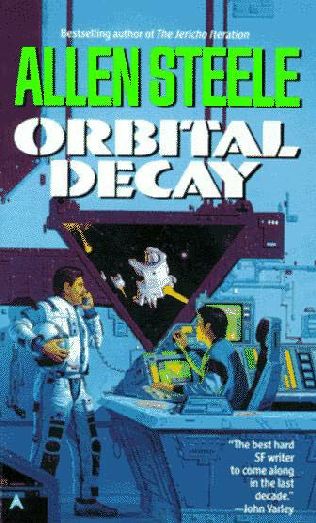I was reading an article at Space.com about the not-often-considered realities that are implied in plans to move into space, and it just makes me want to go find Orbital Decay and read it again.
Here’s a bit of the article:
You see, when we talk about going into space, we usually think about astronauts—pilots, mission specialists, scientists, and the like. Those who have had “the right stuff” have undergone rigorous selection processes and months, usually years of training to learn how to function in space and handle any kind of situation.
Someday soon, hopefully sooner than later, we humans are going to start building things in space—on the Moon—on Mars. We may have extensive transfer stations on orbit, and the plans are well underway for hotels and other recreational facilities “out there.”
Who is going to build them? Maintain them? Repair them when they break?
The same folks who have always done it—the trades people. With just a little thought we can identify a whole host of trades we are going to need. To name a few: electricians, sheet metal workers, heating, ventilation, and air conditioning specialists, plumbers, carpenters, brick and stone masons, fuel handlers, pipe fitters, well, you get the idea.
 That idea is one of the core notions of Orbital Decay (and indeed quite a few of Steele’s early works, both novels and short fiction, focused on the ‘blue collar worker in space’ angle). I haven’t read Orbital Decay since it first came out, but I remember really liking it then. How can you not like the story of the Grateful Dead-fan construction workers pulling a scam on the Big Brother types from the intelligence community? Who knows if the me of now would still like it, but I am suddenly inspired to pull it out and find out.
That idea is one of the core notions of Orbital Decay (and indeed quite a few of Steele’s early works, both novels and short fiction, focused on the ‘blue collar worker in space’ angle). I haven’t read Orbital Decay since it first came out, but I remember really liking it then. How can you not like the story of the Grateful Dead-fan construction workers pulling a scam on the Big Brother types from the intelligence community? Who knows if the me of now would still like it, but I am suddenly inspired to pull it out and find out.
In an interview with Locus several years ago Steele notes that he has a ‘into the river twice’ relationship with the book:
”Lately I took a look at Orbital Decay, which made a big splash when it came out, and is still in print – remarkable for a first novel these days! I’m still very proud of it, and it’s still one of my favorite novels, but I see it now as the work of a 25-year-old kid. I was in grad school at the University of Missouri when I started it, finished it when I was 28, and it was published when I’d turned 31. It’s obviously the work of somebody who was still smoking marijuana and would commonly go to three or four Grateful Dead shows a year. I could not write that book now – I’m a 40-year-old man. I couldn’t write a sequel either, though there’s a lot of people who’d love me to write Orbital Decay 2. If I were to do it, it would be from an extremely different perspective.:
It’s kind of scary that a book I distinctly remember buying as an adult (I guess I was actually 16), as a new release, has now been around for 16 years.
It’s also interesting to note that 16 years have passed two things haven’t changed:
1) We still only send the highly trained elite to space
2) Steele’s orbital construction “near future” stuff still seems just as far off as it did 16 years ago.

